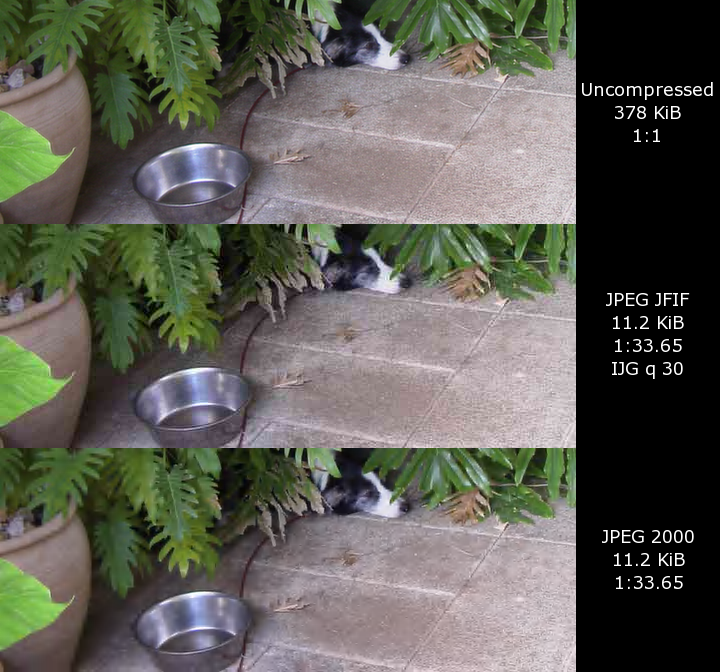JPEG JFIF and 2000 Comparison
Autor:
Attribution:
Obraz jest oznaczony jako „Wymagane uznanie autorstwa” (attribution required), ale nie podano żadnych informacji o uznaniu autorstwa. Prawdopodobnie parametr atrybucji został pominięty podczas korzystania z szablonu MediaWiki dla licencji CC-BY. Autorzy mogą znaleźć tutaj przykład prawidłowego korzystania z szablonów.
Credit:
Praca własna
Krótki link:
źródło:
Wymiary:
720 x 672 Pixel (563605 Bytes)
Opis:
This image is a PNG for a comparison between JPEG (plain, JFIF) and JPEG 2000. I (Shlomi Tal) cut a chunk of the photo (576×224 out of the original 1024×768, to be exact) with the GIMP, then saved to PPM. I then generated a JPEG version of it with a quality of 30 (on the IJG scale), yielding a file size of 11,502 bytes, computed as approximately 1/33.65 of the size of the uncompressed image. After that, I generated a JPEG 2000 version with a compression ratio of 1:33.65, yielding a size of 11,406 bytes. Finally I converted both images to PPM, created the captions (144×224 each) for the three images, stitched them all into one image and converted them to PNG with 0.45455 gamma. With pngcrush I added the text chunks and optimised the file.
I chose quality 30 because compression artifacts are guaranteed at that compression level. The reference uncompressed image is from my camera in lossless mode. The PNG is not interlaced, for I deem interlacing fit only for critical images (such as image maps for navigation) or previewing (which on Wikimedia is taken care of by the thumbnails).
Addendum by BenRG: The original JPEG 2000 image appears to have been created by JasPer with rate=0.03. Kakadu produces a considerably different output at the same file size, with more blurring of prominent edges (e.g. the leaf near the bowl) and less blurring of subtler details. The original JPEG image is IJG quality 30 (with 2×2 chroma subsampling), as advertised, but it was apparently (based on the size) produced with the default Huffman tables instead of optimized tables. With optimized tables (cjpeg -q 30 -opt) the file size is significantly smaller (10,494 bytes). With arithmetic coding (which JPEG 2000 always uses), the file size is 9633 bytes, which is less than 85% of the size of the JPEG 2000 file with no change in quality.
Licencja:
Warunki licencji:
Creative Commons Attribution-Share Alike 3.0
Więcej informacji o licencji można znaleźć tutaj. Ostatnia aktualizacja: Thu, 01 Sep 2022 23:41:49 GMT
